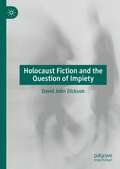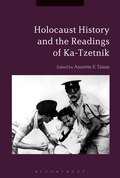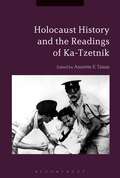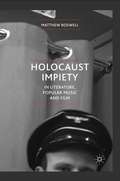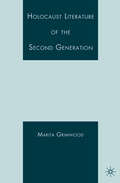- Table View
- List View
Holocaust Fiction
by Sue ViceExamining the controversies that have accompanied the publication of novels representing the Holocaust, this compelling book explores such literature to analyze their violently mixed receptions and what this says about the ethics and practice of millennial Holocaust literature. The novels examined, including some for the first time, are: * Time's Arrow by Martin Amis* The White Hotel by D.M. Thomas* The Painted Bird by Jerzy Kosinski* Schindler's List by Thomas Keneally* Sophie's Choice by William Styron* The Hand that Signed the Paper by Helen Darville. Taking issue with the idea that the Holocaust should only be represented factually, this compelling book argues that Holocaust fiction is not only legitimate, but an important genre that it is essential to accept. In a growing area of interest, Sue Vice adds a new, intelligent and contentious voice to the key debates within Holocaust studies.
Holocaust Fiction and the Question of Impiety
by David John DicksonThis book discusses the issues underlying contemporary Holocaust fiction. Using Gillian Rose’s theory of Holocaust piety, it argues that, rather than enhancing our understanding of the Holocaust, contemporary fiction has instead become overly focused on gratuitous representations of bodies in pain. The book begins by discussing the locations and imagery which have come to define our understanding of the Holocaust, before then highlighting how this gradual simplification has led to an increasing sense of emotional distance from the historical past. Holocaust fiction, the book argues, attempts to close this emotional and temporal distance by creating an emotional connection to bodies in pain. Using different concepts relating to embodied experience – from Sonia Kruks’ notion of feeling-with to Alison Landsberg’s prosthetic memory – the book analyses several key examples of Holocaust literature and film to establish whether fiction still possesses the capacity to approach the Holocaust impiously.
Holocaust History and the Readings of Ka-Tzetnik
by Annette F. TimmHolocaust History and the Readings of Ka-Tzetnik provides the first extensive exploration of the reception of Ka-Tzetnik's work and the role that his books have played in the larger discussion of the Holocaust and its memorialization around the world.Including contributions from an international and interdisciplinary group of experienced scholars, the book examines the literary merits, historical context and public resonance of Ka-Tzetnik's stories. It also places his novels in the context of post-WWII debates about how the memories and testimonies of the victims of the Holocaust can be represented and made publicly accessible through literature. There is also detailed coverage of key topics, like Holocaust memory and sexual violence in the concentration camps, and thorough historical analysis of key works like House of Dolls included throughout.This is an important study for all scholars and students with an interest in the Holocaust and Holocaust literature.
Holocaust History and the Readings of Ka-Tzetnik
by Annette F. TimmHolocaust History and the Readings of Ka-Tzetnik provides the first extensive exploration of the reception of Ka-Tzetnik's work and the role that his books have played in the larger discussion of the Holocaust and its memorialization around the world.Including contributions from an international and interdisciplinary group of experienced scholars, the book examines the literary merits, historical context and public resonance of Ka-Tzetnik's stories. It also places his novels in the context of post-WWII debates about how the memories and testimonies of the victims of the Holocaust can be represented and made publicly accessible through literature. There is also detailed coverage of key topics, like Holocaust memory and sexual violence in the concentration camps, and thorough historical analysis of key works like House of Dolls included throughout.This is an important study for all scholars and students with an interest in the Holocaust and Holocaust literature.
Holocaust History, Holocaust Memory: Jewish Poland and Polish Jews, During and After the Holocaust (Routledge Studies in Second World War History)
by Judith Tydor Baumel-Schwartz Lea GanorThis volume is both a study of the history of Polish Jews and Jewish Poland before, during, and immediately after the Holocaust and a collection of personal explorations focusing on the historians who write about these subjects.While the first three parts of the book focus on "text," the broad nature of Polish Jewish history surrounding the Holocaust, the last section focuses on subtext, the personal and professional experiences of scholars who have devoted years to researching and writing about Polish Jewry. The beginning sections present a variety of case studies on wartime and postwar Polish Jews, drawing on new research and local history. The final part is a reflection on family memory, where scholars discuss their connections to Holocaust history and its impact on their current lives and research. Viewed together, the combination sheds light on both history and historians: the challenges of dealing with the history of an unparalleled cataclysm, and the personal questions and dilemmas that its study raises for many of the historians engaged in it.Holocaust History, Holocaust Memory is a unique resource that will appeal to students and scholars studying the Second World War, Jewish and Polish history, and family history.
Holocaust History, Holocaust Memory: Jewish Poland and Polish Jews, During and After the Holocaust (Routledge Studies in Second World War History)
This volume is both a study of the history of Polish Jews and Jewish Poland before, during, and immediately after the Holocaust and a collection of personal explorations focusing on the historians who write about these subjects.While the first three parts of the book focus on "text," the broad nature of Polish Jewish history surrounding the Holocaust, the last section focuses on subtext, the personal and professional experiences of scholars who have devoted years to researching and writing about Polish Jewry. The beginning sections present a variety of case studies on wartime and postwar Polish Jews, drawing on new research and local history. The final part is a reflection on family memory, where scholars discuss their connections to Holocaust history and its impact on their current lives and research. Viewed together, the combination sheds light on both history and historians: the challenges of dealing with the history of an unparalleled cataclysm, and the personal questions and dilemmas that its study raises for many of the historians engaged in it.Holocaust History, Holocaust Memory is a unique resource that will appeal to students and scholars studying the Second World War, Jewish and Polish history, and family history.
Holocaust Impiety in Literature, Popular Music and Film
by M. BoswellSurveying irreverent and controversial representations of the Holocaust - from Sylvia Plath and the Sex Pistols to Quentin Tarantino and Holocaust comedy - Matthew Boswell considers how they might play an important role in shaping our understanding of the Nazi genocide and what it means to be human.
Holocaust Intersections: Genocide and Visual Culture at the New Millennium
by Axel BangertRecent representations of the Holocaust have increasingly required us to think beyond rigid demarcations of nation and history, medium and genre. Holocaust Intersections sets out to investigate the many points of conjunction between these categories in recent images of genocide. The book examines transnational constellations in Holocaust cinema and television in Europe, disclosing instances of border-crossing and boundary-troubling at levels of production, distribution and reception. It highlights intersections between film genres, through intertextuality and pastiche, and the deployment of audiovisual Holocaust memory and testimony. Finally, the volume addresses connections between the Holocaust and other histories of genocide in the visual culture of the new millennium, engaging with the questions of transhistoricity and intercultural perspective. Drawing on a wide variety of different media - from cinema and television to installation art and the internet - and on the most recent scholarship on responses to the Holocaust, the volume aims to update our understanding of how visual culture looks at the Holocaust and genocide today. With the contributions: Robert S. C. Gordon, Axel Bangert, Libby Saxton- Introduction Emiliano Perra- Between National and Cosmopolitan: 21st Century Holocaust Television in Britain, France and Italy Judith Keilbach- Title to be announced Laura Rascaroli- Transits: Thinking at the Junctures of Images in Harun Farocki's Respite and Arnaud des Pallieres's Drancy Avenir Maxim Silverman- Haneke and the Camps Barry Langford- Globalising the Holocaust: Fantasies of Annihilation in Contemporary Media Culture Ferzina Banaji- The Nazi Killin' Business: A Post-Modern Pastiche of the Holocaust Matilda Mroz- Neighbours: Polish-Jewish Relations in Contemporary Polish Visual Culture Berber Hagedoorn- Holocaust Representation in the Multi-Platform TV Documentaries De Oorlog (The War) and 13 in de Oorlog (13 in the War) Annette Hamilton- Cambodian Genocide: Ethics and Aesthetics in the Cinema of Rithy Panh Piotr Cieplak, Emma Wilson- The Afterlife of Images
Holocaust Intersections: Genocide and Visual Culture at the New Millennium
by Axel BangertRecent representations of the Holocaust have increasingly required us to think beyond rigid demarcations of nation and history, medium and genre. Holocaust Intersections sets out to investigate the many points of conjunction between these categories in recent images of genocide. The book examines transnational constellations in Holocaust cinema and television in Europe, disclosing instances of border-crossing and boundary-troubling at levels of production, distribution and reception. It highlights intersections between film genres, through intertextuality and pastiche, and the deployment of audiovisual Holocaust memory and testimony. Finally, the volume addresses connections between the Holocaust and other histories of genocide in the visual culture of the new millennium, engaging with the questions of transhistoricity and intercultural perspective. Drawing on a wide variety of different media - from cinema and television to installation art and the internet - and on the most recent scholarship on responses to the Holocaust, the volume aims to update our understanding of how visual culture looks at the Holocaust and genocide today. With the contributions: Robert S. C. Gordon, Axel Bangert, Libby Saxton- Introduction Emiliano Perra- Between National and Cosmopolitan: 21st Century Holocaust Television in Britain, France and Italy Judith Keilbach- Title to be announced Laura Rascaroli- Transits: Thinking at the Junctures of Images in Harun Farocki's Respite and Arnaud des Pallieres's Drancy Avenir Maxim Silverman- Haneke and the Camps Barry Langford- Globalising the Holocaust: Fantasies of Annihilation in Contemporary Media Culture Ferzina Banaji- The Nazi Killin' Business: A Post-Modern Pastiche of the Holocaust Matilda Mroz- Neighbours: Polish-Jewish Relations in Contemporary Polish Visual Culture Berber Hagedoorn- Holocaust Representation in the Multi-Platform TV Documentaries De Oorlog (The War) and 13 in de Oorlog (13 in the War) Annette Hamilton- Cambodian Genocide: Ethics and Aesthetics in the Cinema of Rithy Panh Piotr Cieplak, Emma Wilson- The Afterlife of Images
Holocaust Literature and Representation: Their Lives, Our Words (Comparative Jewish Literatures)
by Phyllis Lassner and Judith Tydor Baumel-SchwartzEach scholar working in the field of Holocaust literature and representation has a story to tell. Not only the scholarly story of the work they do, but their personal story, their journey to becoming a specialist in Holocaust studies. What academic, political, cultural, and personal experiences led them to choose Holocaust representation as their subject of research and teaching? What challenges did they face on their journey? What approaches, genres, media, or other forms of Holocaust representation did they choose and why? How and where did they find a scholarly “home” in which to share their work productively? Have political, social, and cultural conditions today affected how they think about their work on Holocaust representation? How do they imagine their work moving forward, including new challenges, responses, and audiences? These are but a few of the questions that the authors in this volume address, showing how a scholar's field of research and resulting writings are not arbitrary, and are often informed by their personal history and professional experiences.
Holocaust Literature and Representation: Their Lives, Our Words (Comparative Jewish Literatures)
Each scholar working in the field of Holocaust literature and representation has a story to tell. Not only the scholarly story of the work they do, but their personal story, their journey to becoming a specialist in Holocaust studies. What academic, political, cultural, and personal experiences led them to choose Holocaust representation as their subject of research and teaching? What challenges did they face on their journey? What approaches, genres, media, or other forms of Holocaust representation did they choose and why? How and where did they find a scholarly “home” in which to share their work productively? Have political, social, and cultural conditions today affected how they think about their work on Holocaust representation? How do they imagine their work moving forward, including new challenges, responses, and audiences? These are but a few of the questions that the authors in this volume address, showing how a scholar's field of research and resulting writings are not arbitrary, and are often informed by their personal history and professional experiences.
Holocaust Literature of the Second Generation
by M. Vaul-GrimwoodExploring five key texts from the emerging canon of second generation writing, this exciting new study brings together theories of autobiography, trauma, and fantasy to understand the how traumatic family histories are represented. In doing so, it demonstrates the continuing impact of familial and community Holocaust trauma, and the need for a precise, clearly developed theoretical framework in which to situate these works. This book will appeal to final year undergraduates and postgraduate students, as well as scholars in literary and Holocaust-related fields, and an audience with personal and professional interests in the 'second generation'.
The Holocaust Novel (Genres in Context)
by Efraim SicherThe first comprehensive study of Holocaust literature as a major postwar literary genre, The Holocaust Novel provides an ideal student guide to the powerful and moving works written in response to this historical tragedy. This student-friendly volume answers a dire need for readers to understand a genre in which boundaries and often blurred between history, fiction, autobiography, and memoir. Other essential features for students here include an annotated bibliography, chronology, and further reading list. Major texts discussed include such widely taught works as Night, Maus, The Shawl, Schindler's List, Sophie's Choice, White Noise, and Time's Arrow.
The Holocaust Novel (Genres in Context)
by Efraim SicherThe first comprehensive study of Holocaust literature as a major postwar literary genre, The Holocaust Novel provides an ideal student guide to the powerful and moving works written in response to this historical tragedy. This student-friendly volume answers a dire need for readers to understand a genre in which boundaries and often blurred between history, fiction, autobiography, and memoir. Other essential features for students here include an annotated bibliography, chronology, and further reading list. Major texts discussed include such widely taught works as Night, Maus, The Shawl, Schindler's List, Sophie's Choice, White Noise, and Time's Arrow.
Holocaust Representation: Art within the Limits of History and Ethics
by Berel LangSince Theodor Adorno's attack on the writing of poetry "after Auschwitz," artists and theorists have faced the problem of reconciling the moral enormity of the Nazi genocide with the artist's search for creative freedom. In Holocaust Representation, Berel Lang addresses the relation between ethics and art in the context of contemporary discussions of the Holocaust. Are certain aesthetic means or genres "out of bounds" for the Holocaust? To what extent should artists be constrained by the "actuality" of history—and is the Holocaust unique in raising these problems of representation?The dynamics between artistic form and content generally hold even more intensely, Lang argues, when art's subject has the moral weight of an event like the Holocaust. As authors reach beyond the standard conventions for more adequate means of representation, Holocaust writings frequently display a blurring of genres. The same impulse manifests itself in repeated claims of historical as well as artistic authenticity. Informing Lang's discussion are the recent conflicts about the truth-status of Benjamin Wilkomirski's "memoir" Fragments and the comic fantasy of Roberto Benigni's film Life Is Beautiful. Lang views Holocaust representation as limited by a combination of ethical and historical constraints. As art that violates such constraints often lapses into sentimentality or melodrama, cliché or kitsch, this becomes all the more objectionable when its subject is moral enormity. At an extreme, all Holocaust representation must face the test of whether its referent would not be more authentically expressed by silence—that is, by the absence of representation.
Holocaust Representations in History: An Introduction
by Daniel H. Magilow Lisa SilvermanHolocaust Representations in History is an introduction to critical questions and debates surrounding the depiction, chronicling and memorialization of the Holocaust through the historical analysis of some of the most provocative and significant works of Holocaust representation.In a series of chronologically presented case studies, the book introduces the major themes and issues of Holocaust representation across a variety of media and genres, including film, drama, literature, photography, visual art, television, graphic novels, and memorials. The case studies presented not only include well-known, commercially successful, and canonical works about the Holocaust, such as the film Shoah and Elie Wiesel's memoir Night, but also controversial examples that have drawn accusations of profaning the memory of the genocide. Each work's specific historical and cultural significance is then discussed to provide further insight into the impact of one of the most devastating events of the 20th century and the continued relevance of its memory.Complete with illustrations, a bibliography and suggestions for further reading, key terms and discussion questions, this is an important book for any student keen to know more about the Holocaust and its impact.
Holocaust Representations in History: An Introduction (Perspectives On The Holocaust Ser.)
by Daniel H. Magilow Lisa SilvermanHolocaust Representations in History is an introduction to critical questions and debates surrounding the depiction, chronicling and memorialization of the Holocaust through the historical analysis of some of the most provocative and significant works of Holocaust representation.In a series of chronologically presented case studies, the book introduces the major themes and issues of Holocaust representation across a variety of media and genres, including film, drama, literature, photography, visual art, television, graphic novels, and memorials. The case studies presented not only include well-known, commercially successful, and canonical works about the Holocaust, such as the film Shoah and Elie Wiesel's memoir Night, but also controversial examples that have drawn accusations of profaning the memory of the genocide. Each work's specific historical and cultural significance is then discussed to provide further insight into the impact of one of the most devastating events of the 20th century and the continued relevance of its memory.Complete with illustrations, a bibliography and suggestions for further reading, key terms and discussion questions, this is an important book for any student keen to know more about the Holocaust and its impact.
The Holocaust Short Story
by Mary Catherine MuellerThe Holocaust Short Story is the only book devoted entirely to representations of the Holocaust in the short story genre. The book highlights how the explosiveness of the moment captured in each short story is more immediate and more intense, and therefore recreates horrifying emotional reactions for the reader. The main themes confronted in the book deal with the collapse of human relationships, the collapse of the home, and the dying of time in the monotony and angst of surrounding death chambers. The book thoroughly introduces the genres of both the short story and Holocaust writing, explaining the key features and theories in the area. Each chapter then looks at the stories in detail, including work by Ida Fink, Tadeusz Borowski, Rokhl Korn, Frume Halpern, and Cynthia Ozick. This book is essential reading for anyone working on Holocaust literature, trauma studies, Jewish studies, Jewish literature, and the short story genre.
The Holocaust Short Story
by Mary Catherine MuellerThe Holocaust Short Story is the only book devoted entirely to representations of the Holocaust in the short story genre. The book highlights how the explosiveness of the moment captured in each short story is more immediate and more intense, and therefore recreates horrifying emotional reactions for the reader. The main themes confronted in the book deal with the collapse of human relationships, the collapse of the home, and the dying of time in the monotony and angst of surrounding death chambers. The book thoroughly introduces the genres of both the short story and Holocaust writing, explaining the key features and theories in the area. Each chapter then looks at the stories in detail, including work by Ida Fink, Tadeusz Borowski, Rokhl Korn, Frume Halpern, and Cynthia Ozick. This book is essential reading for anyone working on Holocaust literature, trauma studies, Jewish studies, Jewish literature, and the short story genre.
Holocaust Survivors in Postwar Britain: Community and Belonging
by Ellis SpicerThis book pays particular attention to the experiences of younger child survivors of the Holocaust, considering how they kept in touch with one another, and how they integrated into larger cohorts of survivors settling in postwar Britain. Digging deeper than ever before into their postwar circumstances exposes the process of rebuilding shattered lives and the evolution of community relations, including both the beneficial and re-traumatising effects engendered by these networks. Newly conducted interviews put the experiences of younger survivors centre stage. These individuals did not receive much attention or status as survivors until the 1990s, and whilst they represent the most active cohort of survivor speakers in the UK, their narratives and community relations have been markedly absent from academic study.
The Holy and the Daemonic from Sir Thomas Browne to William Blake
by Robert D. StockFocusing particularly on literary texts, but including biographical and intellectual background, this study examines numinous feeling as it is recorded by a number of seventeenth and eighteenth-century writers: Browne, Drydcn, Pascal; Pope and Swift; Hume and Johnson; eight other poets, including Watts, Smart, Cowper, and Blake; and four novelists, including Richardson, Radcliffe, and Monk" Lewis. Professor Stock demonstrates that the Enlightenment was far more complicated than can be grasped by an exclusive focus on its rationalism and skepticism.Originally published in 1982.The Princeton Legacy Library uses the latest print-on-demand technology to again make available previously out-of-print books from the distinguished backlist of Princeton University Press. These editions preserve the original texts of these important books while presenting them in durable paperback and hardcover editions. The goal of the Princeton Legacy Library is to vastly increase access to the rich scholarly heritage found in the thousands of books published by Princeton University Press since its founding in 1905.
Holy Delight: Typology, Numerology, and Autobiography in Donne's "Devotions upon Emergent Occasions"
by Kate Gartner FrostComposed on the occasion of the poet's near-fatal bout with typhus in 1623, the Devotions contains the essential germ of John Donne's mature thought, embodied in obscurely structured verse/prose divisions. Because of its seeming digressiveness, critics have struggled to understand this most significant of Renaissance texts as a whole. Kate Gartner Frost, however, shows that the Devotions, which combines odd bits of natural history, personal life-data, quotations from scripture, and descriptions of unpleasant medical nostrums with personal religious outpourings, is a unified work belonging to the tradition of English devotional literature and spiritual autobiography from Augustine onward. Frost examines how Donne patterned his work on models and structures that allowed the blending of chronology, experience, anecdote, and insight into the fullness of extended metaphor reflecting the human condition. Donne's use of biblical typology is treated, as well as his adherence to a poetics rooted in pre-Copernican cosmology, which relies on underlying spatial structures. Finally, Frost reveals the actual numerological structures present in the Devotions and addresses the problem of discursive reading in relation to spatially organized premodern works.Originally published in 1991.The Princeton Legacy Library uses the latest print-on-demand technology to again make available previously out-of-print books from the distinguished backlist of Princeton University Press. These editions preserve the original texts of these important books while presenting them in durable paperback and hardcover editions. The goal of the Princeton Legacy Library is to vastly increase access to the rich scholarly heritage found in the thousands of books published by Princeton University Press since its founding in 1905.
Holy Digital Grail: A Medieval Book on the Internet (Stanford Text Technologies)
by Michelle R. WarrenMedieval books that survive today have been through a lot: singed by fire, mottled by mold, eaten by insects, annotated by readers, cut into fragments, or damaged through well-intentioned preservation efforts. In this book, Michelle Warren tells the story of one such manuscript—an Arthurian romance with textual origins in twelfth-century England now diffused across the twenty-first century internet. This trajectory has been propelled by a succession of technologies—from paper manufacture to printing to computers. Together, they have made literary history itself a cultural technology indebted to colonial capitalism. Bringing to bear media theory, medieval literary studies, and book history, Warren shows how digital infrastructures change texts and books, even very old ones. In the process, she uncovers a practice of "tech medievalism" that weaves through the history of computing since the mid-twentieth century; metaphors indebted to King Arthur and the Holy Grail are integral to some of the technologies that now sustain medieval books on the internet. This infrastructural approach to book history illuminates how the meaning of literature is made by many people besides canonical authors: translators, scribes, patrons, readers, collectors, librarians, cataloguers, editors, photographers, software programmers, and many more. Situated at the intersections of the digital humanities, library sciences, literary history, and book history, Holy Digital Grail offers new ways to conceptualize authorship, canon formation, and the definition of a "book."
The Holy Fool in European Cinema (Routledge Studies in Religion and Film)
by Alina G. BirzacheThis monograph explores the way that the profile and the critical functions of the holy fool have developed in European cinema, allowing this traditional figure to capture the imagination of new generations in an age of religious pluralism and secularization. Alina Birzache traces the cultural origins of the figure of the holy fool across a variety of European traditions. In so doing, she examines the critical functions of the holy fool as well as how filmmakers have used the figure to respond to and critique aspects of the modern world. Using a comparative approach, this study for the first time offers a comprehensive explanation of the enduring appeal of this protean and fascinating cinematic character. Birzache examines the trope of holy foolishness in Soviet and post-Soviet cinema, French cinema, and Danish cinema, corresponding broadly to and permitting analysis of the three main orientations in European Christianity: Orthodox, Catholic, and Protestant. This study will be of keen interest to scholars of religion and film, European cinema, and comparative religion.
The Holy Fool in European Cinema (Routledge Studies in Religion and Film)
by Alina G. BirzacheThis monograph explores the way that the profile and the critical functions of the holy fool have developed in European cinema, allowing this traditional figure to capture the imagination of new generations in an age of religious pluralism and secularization. Alina Birzache traces the cultural origins of the figure of the holy fool across a variety of European traditions. In so doing, she examines the critical functions of the holy fool as well as how filmmakers have used the figure to respond to and critique aspects of the modern world. Using a comparative approach, this study for the first time offers a comprehensive explanation of the enduring appeal of this protean and fascinating cinematic character. Birzache examines the trope of holy foolishness in Soviet and post-Soviet cinema, French cinema, and Danish cinema, corresponding broadly to and permitting analysis of the three main orientations in European Christianity: Orthodox, Catholic, and Protestant. This study will be of keen interest to scholars of religion and film, European cinema, and comparative religion.

